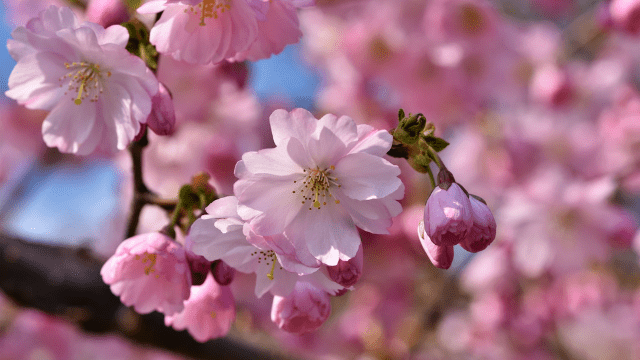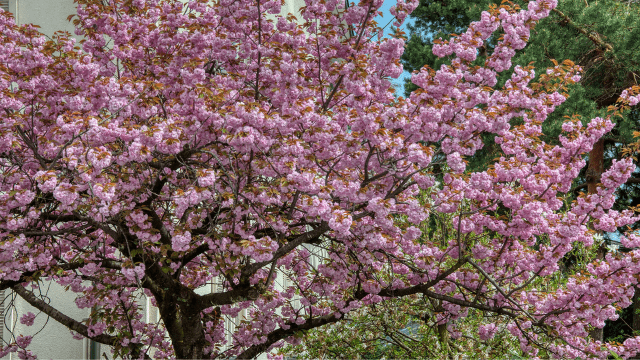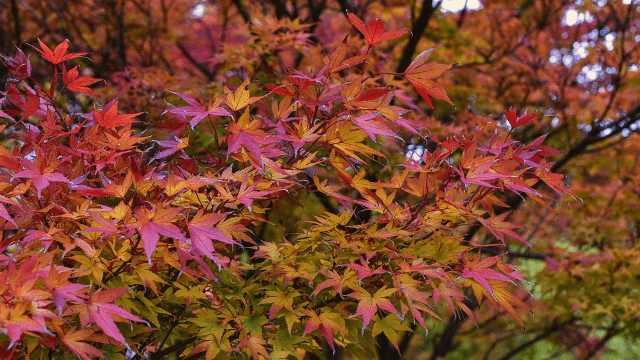If you have a small area in your yard, and you want to plant a tree, there is a solution in the form of trees that will bring exoticism to your home. The listed species are suitable for growing in urban areas, and what is perhaps the most important item for most people – there are no requirements regarding growing conditions.

Tree planting is known to be during the autumn months better choice because the combination of cold temperatures and autumn precipitation allows the trees to establish roots, and the trees are provided an additional growing season before summer stress.
The fact is that planting trees is very important for improving air quality, and afforestation has a key ecological aspect. In addition, you will make another contribution to the planet – you will provide good pasture for bees during the spring months, as honey plants are concerned. We highlight the following five types for you.
Japanese red leaf cherry
This plant is certainly best known for its beautiful pink flowers which appear on the branches at the end of April and at the beginning house month. The flowers of the Japanese red-leaf cherry are double and spherical, they open before the leaves of the plant.
They have five petals, are sterile and no fruits. In addition to its unreal appearance, the flowers of this plant, which reaches a height of approx 6 metersand its crown is about 5, they have an intoxicating smell and they attract bees and provide them with pasture.
And the leaf is equally decorative. The leaves change from green to burgundy shade until it falls off, presenting a kind of autumnal attraction. The leaves have an egg-shaped shape and a slightly serrated edge.
It is cultivated in Japan more than 200 varieties of this decorative deciduous tree. An important characteristic of it is its good resistance caused by strong roots. It tolerates city conditions well, but also high temperatures during the summer and lack of precipitation. In addition, it is important to emphasize that the Japanese red-leaf cherry is tolerant to temperatures of even -30 degrees.
This plant can be planted on its own, while in parks and on larger areas it is also seen tree line and in combination with other lower trees.
It grows best on slightly acidic pH soil 4,5 do 7. The land must be well drained. This plant can be attacked monilia causing damage to beautiful flowers and saplings.


Trees for small yards: red-leaved plum
Another garden plant valued for its flowers and leaves and in this case also ease of maintenance. Namely, this deciduous tree has regular, round crown width up to 5 meters, and does not require pruning.
The flower is of delicate color – between white and pink, and flowering is abundant, visible in the third decade of March. Provide this plant sunny position so that the flowers have an intense color, because it is lost in the shade.
When it comes to leaves, they really bring warmth during the autumn months with their own in red color. Another important characteristic – the leaves they decrease uniformly which is a big plus when collecting them and spending time. They are pointed at the top.
They appear on the tree round – ovoid fruits. They are visible on the tree in the fifth month of the calendar.
Another name for this plant is Japanese plum. It can be grown alone or in a row of trees (distance between trees 5 meters). She is very tolerant – she tolerates it most land typesbut also the cold during the winter months, and can survive without problems at the temperature do -35. This plant, which reaches a height of up to 8 meters, shows resistance to frosts, and it is best to choose sunny and semi-shaded positions for its cultivation.


A Jewess
You must have seen this tree in the parks. The main characteristic of this deciduous tree is kauliflorijathe beautiful flowers of this tree do not appear only on its thin branches, but grow and from the treebefore scrolling occurs.
Botanists are of the opinion that this occurs because the juda tree provides for itself better pollination in a natural way.
It is a tree that is considered one of the oldest on the planet on which we live. Among the Mediterranean peoples – Spanish and Italians it is known as the tree of love. This is not without reason, namely the juda tree has a delicate color of flowers and heart-shaped leaves.
The flowers are about 2 centimeters long and have dark pink color. The Judas tree blooms profusely at the end of April/beginning of May. Blooms after five years from planting, flowers are sensitive to cold, which should be taken into account when choosing a planting position. There is an abundance of nectar in the flowers. The flowers are gathered in clustered inflorescences.
When it comes to the leaves, it takes over after flowering to decorate As mentioned above, the leaves are heart-shaped. Leafing occurs during May and remains on the tree until place in the month of November. During the change of seasons, the leaves change from green to green-yellow and then to brown.


There is also a fruit that is a brown pod of a lighter shade, hanging and flattened. The pods remain on the tree during the winter months, until early spring.
A Judas tree can grow up to 12 meters. It belongs to the family legumesand therefore has power nitrogen fixation (on its well-developed, strong roots, there are bacteria that make it possible to bind nitrogen from the atmosphere and convert it into a form available to plants). The bark of the tree is thin and slightly cracked.
Because it can be grown in a pot, the juda tree is a favorite among hobbyists bonsai techniques. It is propagated by seeds and cuttings. cuttings are more recommended because by propagating using seeds, we do not get an identical plant as the parent plant.
Do you know: Why is it best to plant trees in autumn?
This plant not a big fan of transplanting and it is difficult to tolerate it, so it is important to immediately choose a good position for planting. Let it be a fully sunny and warm position or mild hay, as well drained land. It doesn’t require a lot of watering, it can tolerate dry days well. Pruning should only be done if the branches have suffered from frost. He can attack him your shield.
Trees for small yards: Japanese maple
This tree is very decorative because of its leaves which change colors during the months into the most beautiful shades; they are first light green buoys at the beginning, when leafing occurs, a very intense green color during the summer months, while during the fall it is leafy golden and reddishtakes magical appearance. Even in winter it is a decoration in the garden, because it has an interesting tangle of branches which look very decorative on the bare tree.


This low deciduous oval crown (although in nature it reaches a height of 7 meters, in the garden it reaches about 3; the canopy has the shape of an umbrella), it is best to grow independentlybut it can also be grown in combination with bushes or else low conifers.
Canopy does not require pruning (unless the branches are damaged by frost or disease), because it is beautiful and without that measure, which is difficult for many gardeners. This plant is also propagated by cuttings or seeds (the same story as with the juda tree). It is also, like the juda tree, a frequent choice of lovers bonsai techniques.
The leaves are long 5-10 centimeters. The flowers that are small and reddish they appear during May and June in clustered inflorescences.
Japanese maple likes little more acidic soils with good drainage, it is sensitive to water retention around the roots. If you miss regular watering, you won’t do much harm to the plant, except that it will affect it exuberance.
Japanese maple: Unsurpassed garden decor
Make your choice for planting in a sunny or semi-shaded position. Just pay attention: if the plant is too much in the shade, the intensity of the color of the leaves will not be as pronounced and magical, as it would be if the plant is exposed to the sun’s rays. However, hot wind and too strong sun can lead to drying of leaf tips thus distorting their appearance.
It is important that the place where the Japanese maple will be planted is protected from strong winds.
In April, one supplement is required slow-dissolving fertilizer. During the first three years after planting, during the winter months, it is necessary to provide the young plant acrylic.
The mourning elm
This plant is very interesting because of its crown in in the form of an umbrellathat is, mushrooms, and represents an interesting decoration in the garden. A table and chairs for sitting can be placed under the larger weeping elms because this plant provides “thick” cold. And this plant has an interesting, interlaced canopy with thick branches bent to the ground, so it is also a winter decoration in the garden.
The mourning elm is usually planted singly or in pairs in the yard. The growth of this plant depends on Visine Kalemljenjawhich generally does not exceed more than 2 metra. The width of the weeping elm very often exceeds the height. The bark of the tree changes from smooth to rough with age corky texture. The leaves are large, dark green, interestingly toothed, later they become red autumn color palette: from golden yellow to reddish.


A very resistant plantcan be grown on almost all types of soil, tolerates well low winter temperatures, ali i frost and drought.
As with the other mentioned species, it is necessary to choose a sunny position or semi-shade. Pruning is done before leafing, in order to obtain a denser structure and shape the crown. It is desirable mulching. Pay attention that when watering, you also provide water to the soil outside the crown zone, because the root branches widely below the surface of the soil.
Source: www.agromedia.rs


